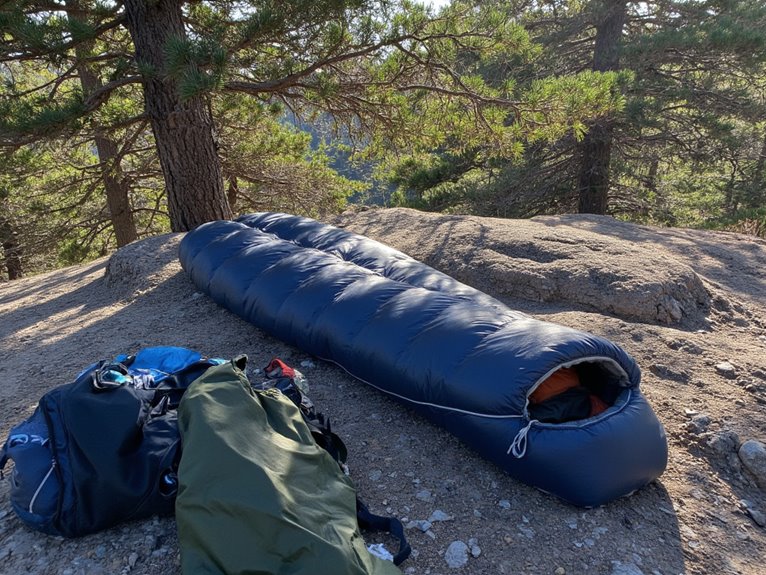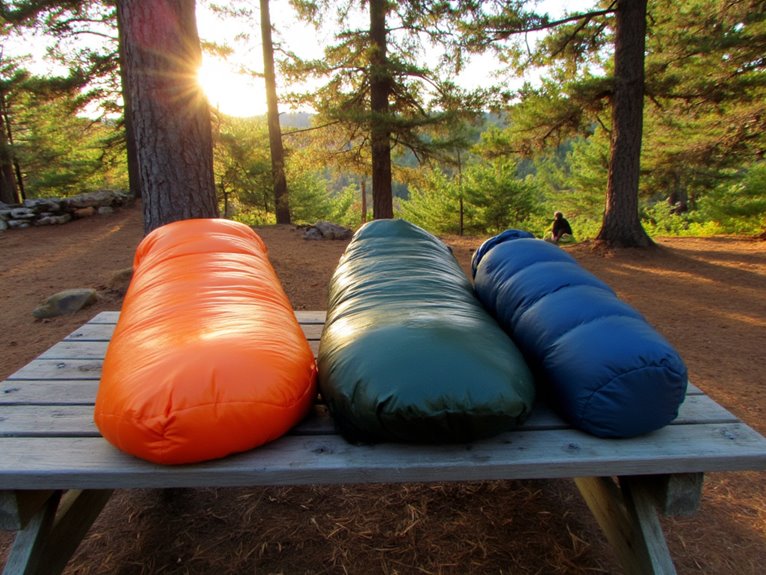How to Choose the Right Sleeping Bag for Your Outdoor Adventures
Start by matching your sleeping bag’s temperature rating to expected nighttime conditions, selecting comfort ratings 10-15°F below anticipated lows. Choose down insulation for superior warmth-to-weight ratios and compressibility, or synthetic fills for moisture resistance and budget-friendly performance. Select mummy shapes for maximum thermal efficiency or rectangular designs for car camping comfort. Guarantee proper fit-regular bags suit 160-175cm heights while long versions accommodate 175-190cm users. Consider weight carefully: ultralight backpacking requires sub-2-pound bags, while car camping allows 4+ pound options for enhanced comfort and features that optimize your outdoor experience.
We are supported by our audience. When you purchase through links on our site, we may earn an affiliate commission, at no extra cost for you. Learn more. Last update on 5th January 2026 / Images from Amazon Product Advertising API.
Notable Insights
- Consider down insulation for superior warmth-to-weight ratio and compressibility, or synthetic insulation for moisture resistance and affordability.
- Choose temperature ratings slightly below expected nighttime temperatures, with women prioritizing comfort ratings over limit ratings.
- Select mummy bags for maximum thermal efficiency or rectangular bags for car camping comfort and extra space.
- Ensure proper fit by matching bag length and width to your height, shoulder width, and hip circumference.
- Prioritize lightweight, compressible options under 2 pounds for backpacking or heavier 4+ pound bags for car camping.
Understanding Insulation Materials and Their Performance Characteristics
When selecting a sleeping bag, the insulation material fundamentally determines your comfort, safety, and pack weight during outdoor adventures. The down vs synthetic debate centers on specific performance trade-offs.
Down provides superior warmth-to-weight ratios and exceptional compressibility, making it ideal for backpacking where weight matters. However, down loses insulating power when wet and costs more. Down products can last decades with proper care, making them a worthwhile investment for serious outdoor enthusiasts. The fill power rating indicates the down’s quality and lofting ability.
Down insulation excels in weight and packability but fails when wet and demands higher investment costs.
Synthetic insulation retains warmth in moisture, costs less, and suits allergy-prone users. It’s bulkier and less durable long-term. Synthetic options are also water-resistant compared to down, making them reliable in unpredictable weather conditions. Many modern synthetic sleeping bags feature 210D polyester construction for enhanced durability and weather resistance.
Hybrid advantages include combining down’s lightweight warmth with synthetic’s moisture resistance. This creates balanced performance for wet conditions where pure down fails.
Consider your budget, expected weather conditions, and activity type when choosing between these insulation types.
Decoding Temperature Ratings for Safe and Comfortable Sleep

Temperature ratings represent the most critical safety specification on any sleeping bag, yet they’re often misunderstood by outdoor enthusiasts.
These ratings come from standardized EN or ISO lab tests using heated mannequins to simulate human heat loss. The tests produce three key thresholds: Comfort, Limit, and Extreme ratings.
Comfort ratings indicate temperatures where cold sleepers can sleep without stress. Limit ratings show minimum temperatures for warm sleepers before discomfort begins.
These ratings reflect different user conditions based on gender physiology differences. Women should prioritize comfort ratings, while men can consider limit ratings sufficient.
Select bags with ratings slightly below expected nighttime temperatures. Your sleeping bag works as part of a larger sleep system that includes an insulating pad and potentially a liner for optimal warmth and comfort. Remember that individual factors like metabolism, clothing, and shelter affect actual performance beyond laboratory results.
Cold sleepers who naturally feel chilly should consider bags with lower limit ratings to ensure adequate warmth throughout the night.
For extreme cold conditions, specialized sleeping bags with dual-layer insulation technology provide enhanced thermal performance and protection against dangerous temperature drops.
Selecting the Optimal Shape for Your Camping Conditions
While temperature ratings determine your safety threshold, sleeping bag shape directly impacts your comfort level and the bag’s thermal efficiency throughout the night. Your shape comparison should begin with understanding three primary designs.
Sleeping bag shape determines both your comfort throughout the night and the bag’s overall thermal efficiency performance.
Rectangular bags offer maximum space for movement but sacrifice thermal efficiency due to excess airspace. Semi-rectangular models provide moderate roominess while improving heat retention. Mummy bags deliver superior warmth-to-weight ratios through tapered construction that minimizes dead air space.
Match your choice to specific camping conditions. Car camping allows rectangular bags since weight isn’t critical. Backpacking demands mummy designs for their superior packability and thermal performance.
Consider your sleeping style-restless sleepers need rectangular space, while stationary sleepers benefit from mummy efficiency. Zipper configurations affect ventilation control, while features like draft collars enhance thermal performance regardless of shape selection.
Finding the Perfect Size and Fit for Maximum Efficiency
Three significant measurements determine whether your sleeping bag will deliver optimal thermal performance: your height, shoulder width, and hip circumference.
Regular bags accommodate heights of 160-175 cm, while long versions fit 175-190 cm users. Standard shoulder widths measure around 75 cm for ideal roominess without heat loss.
Hip measurements of 60 cm and foot widths of 50 cm prevent circulation restriction. Size adjustment becomes essential at range boundaries-size up for comfort or down for enhanced insulation.
Women benefit from narrower shoulders and wider hips in bag design, while men require broader shoulder dimensions.
Movement flexibility varies with internal space.
Snug fits maximize thermal efficiency but may cause discomfort. Side sleepers need slightly wider bags for proper arm positioning, balancing warmth retention with natural sleep movement.
When pairing your sleeping bag with a sleeping pad, ensure the pad dimensions complement your bag size for optimal comfort and insulation from the ground.
Balancing Weight and Packability for Your Adventure Type
Your adventure type directly determines the acceptable weight and bulk limits for your sleeping bag selection. Ultralight backpacking demands bags under 2 pounds with maximum compressibility benefits, while car camping allows heavier, roomier designs without portability concerns.
| Adventure Type | Weight Range | Priority Focus |
|---|---|---|
| Fastpacking/Thru-hiking | Under 2 lbs | Maximum compression |
| General Backpacking | 2-4 lbs | Balanced comfort/weight |
| Car Camping | 4+ lbs | Comfort over weight |
Down insulation provides superior weight savings compared to synthetic fills, compressing to half the packed size. High fill power down (900+) maximizes insulation efficiency while minimizing bulk. Mummy shapes offer the best weight-to-warmth ratio but restrict movement. Rectangular bags prioritize comfort over packability. Consider your movement speed requirements-faster travel benefits from highly compressible sleeping systems that won’t slow your progress. For extreme cold conditions where traditional insulation may fall short, heated sleeping bags with battery-powered heating elements can provide additional warmth while maintaining reasonable portability for outdoor enthusiasts.
Essential Features That Enhance Warmth and Convenience
Modern sleeping bags incorporate numerous design elements that directly impact thermal performance and field usability.
Draft collars create vital neck seals that prevent warm air escape while blocking cold infiltration around your torso. These adjustable barriers work alongside insulated zippers featuring thermal baffles that eliminate cold spots along closure lines.
Draft collars and insulated zippers form critical thermal barriers, preventing heat loss while blocking cold air infiltration around vulnerable closure points.
Hood design markedly affects heat retention. Snug-fitting hoods reduce head heat loss by up to 40% in sub-freezing conditions. Mummy shapes outperform rectangular designs by minimizing internal air volume that your body must heat.
Shell treatments enhance durability and moisture resistance. DWR-coated polyester and nylon fabrics repel external moisture while maintaining breathability.
Two-way zippers with multiple sliders provide precise ventilation control. Integrated stash pockets secure essentials within easy reach.
Compression sacks reduce pack volume by 60-70% compared to loose storage.
On a final note
You’ve now got the technical knowledge to select a sleeping bag that matches your specific adventure requirements. Consider your typical camping temperatures, pack weight limits, and shelter conditions. Don’t compromise on fit-a properly sized bag maximizes thermal efficiency. Test your chosen bag before critical trips to verify comfort and warmth ratings. Your sleeping system directly impacts safety and enjoyment, so invest in quality gear that’ll perform reliably across multiple seasons and environments.

